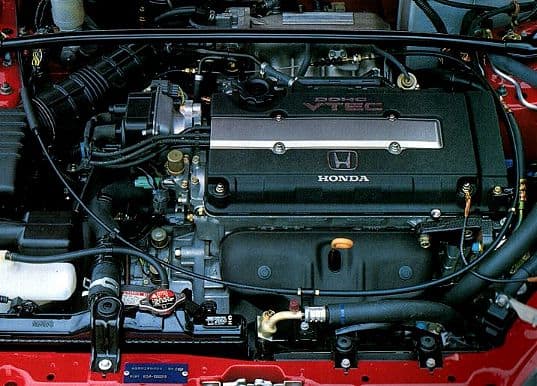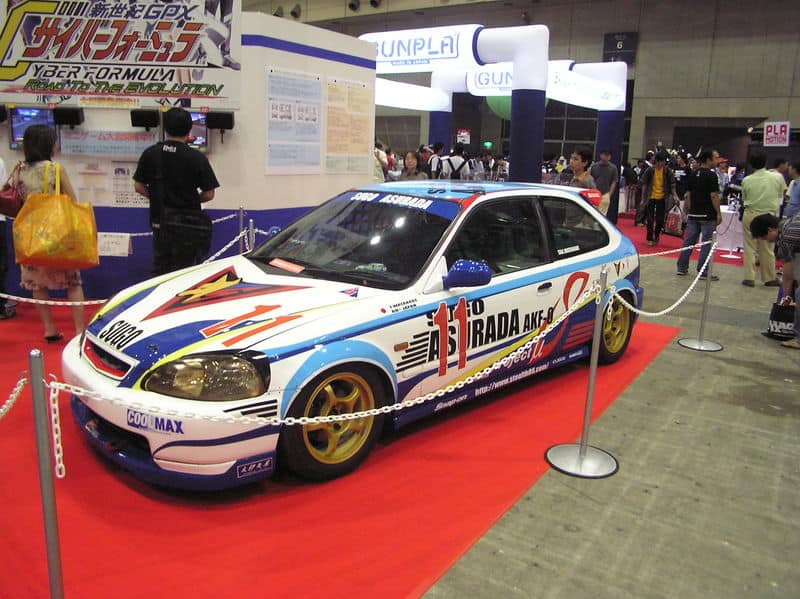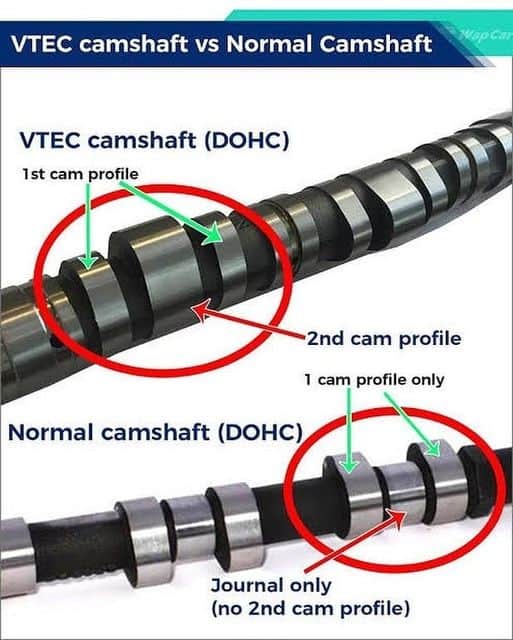
The Honda Civic EK9 Type R has been a sought after favorite in the tuning world since its release in 1997 with it being the first ever Civic to receive the Type R emblem along with some major performance upgrades that would put the EK9 Type R firmly on the map in the motorsport world.
The Honda Civic EK9 Type R has a 1.6 liter DOHC VTEC, naturally aspirated, 16 valve, four stroke engine which produces 182BHP @ 8200 rpm and 163 Nm (120 ft-lb) of torque. The Civic EK9 Type R has a screaming rev limit of 8400 rpm with VTEC engaging (kicking in) at 6200 rpm.
The EK9 Honda Civic even still to this day is a remarkable car and has well and truly stood the test of time still being as popular as ever amongst petrol heads and enthusiast around the globe.
What Engine is in the EK9 Civic?
The EK9 Honda Civic has a 1.6L B16B DOHC VTEC naturally aspirated, 16 valve, four stroke engine. The B16B engine was the first ever production 1.6L engine capable of producing 182 bhp out of the factory.
This remarkable power from such a small engine was achieved by using the same long block used in the B18 and B20 engines. Combining the B18 long block with custom long con rods and a 1.6L stroked crankshaft the engine was de-stroked to 1595 cc giving this little 1.6L engine a deck height of 212mm instead of 203.9mm which was found in the previous 170 bhp B16A engine.

Along with using a longer block Honda also hand ported and polished the cylinder head of every EK9 B16B engine, producing a massive increase in the flow of the air/fuel mixture entering the cylinders plus slightly increasing compression from 10.4 to 10.8.
To get the last 12 bhp out of the EK9 B16B engine Honda also used an upgraded fully balanced 8 weight crankshaft, high lift dual valve springs, high compression custom pistons along with custom lightweight conrods and aggressive high lift camshafts giving this little four cylinder powerhouse a remarkable 182 bhp @ 8200 rpm.
Honda Civic EK9 Type R Specs
| Powertrain Specs | |
| Engine Type | 4 cylinder, 16valve DOHC VTEC B16B |
| Displacement (cc) | 1.6L (98 ci) 1595 cc |
| Power | 85 ps (182 bhp / 136 kw) @ 8200 rpm |
| Torque | 163 Nm (120 ft-lb) @ 8200 rpm |
| Power/weight ratio | 172 ps (170 bhp) / t |
| Torque/weight ratio | 152 Nm (112 ft-lb) / t |
| Transmission | 5 speed manual |
| Layout | (f,f) front engine, front wheel drive |
| Drivetrain/Transmission Specs | |
| Transmission | 5 speed, manual |
| 1st gear ratio | 3.230 |
| 2nd gear ratio | 2.105 |
| 3rd gear ratio | 1.458 |
| 4th gear ratio | 1.107 |
| 5th gear ratio | 0.848 |
| Final drive gear ratio | 4.400 |
| Performance | |
| 0 – 50 kph | 2.9 sec |
| 0 – 100 kph | 6.8 sec |
| 0 – 180 kph | 26.0 sec |
| Quarter mile | 15.3 sec |
| Top speed | 225 kph (140 mph) |
| VTEC Engages | @ 6200 rpm |
| Rev limit | @ 8400 rpm |
How Much Does a EK9 Weight
A Honda Civic EK9 weights from 1,050-1,070 kg (2,315-2,359 lbs). Honda made weight reduction an important factor when designing the EK9 Honda Civic. The EK9 came without sound proofing, A/C, electric windows, sunroof, ABS brakes, rear window wiper/washer and booth lid brake light.
The EK9 Honda Civic was designed to be as light and rigid as possible. In 1998 Honda released the Civic Type R Sports Edition which even came with steel wheels, along with no A/C, a standard grey EK dash, manual windows/mirrors, no sunroof or rear wiper motor.

The Civic Type Rx model which was released in 1999 was Hondas flagship model and it came with all the bells and whistles. The Type Rx came equipped with auto A/C, keyless entry, carbon Type R centre console, aluminum sports pedals, electric windows and retractable mirrors.
Comparing the earlier version of the Civic EK4 to the Civic EK9, the weight difference is pretty impressive, with the EK4 weighting in at 1,090 kg (2,403 lb) and the EK9 weighting 1,050 kg (2,315 lb).
| Chassis/Dimensions | |
| Wheelbase | 2,620 mm (103.1 in) |
| Length | 4,180 mm (164.6 in) |
| Width | 1,695 mm (66.7 in) |
| Height | 1,360 mm (53.5 in) |
| Weight | 1,050 – 1,070 kg (2,315 – 2,359 lbs) |
Is The Civic EK9 Front Wheel Drive
The Honda Civic EK9 is a front engine, front wheel drive, 3 door hatchback with a wheelbase of 2,620mm and a 182 bhp, four cylinder, DOHC VTEC engine.
Honda mainly focused on producing FWD cars because they provided better traction when cornering largely due to having the weight of the engine over the front wheels. Traction and track times were a major factor when it came to the design of Hondas, although in 1990 Honda unleased the 290 bhp RWD Honda NSX, then again in 1999 when the RWD Honda S2000 and the 4WD Civic Ferio RTi were released in Japan.
Is There a 4WD Honda Civic
Honda released the 4WD Honda Civic Ferio RTi in 1999 on the Japanese Market until mid 2000. The Ferio was a four door sedan powered by a 1.6L, 16 valve, four cylinder engine producing 118 bhp and 144Nm (106 ft-lb) of torque running 0-60 mph in 10 seconds, with a quarter mile time of 17.4 seconds.

Does VTEC make your car faster?
VTEC makes a car faster by 50 bhp on average, this is possible due to the aggressive high lift camshafts in the VTEC engine which allows the valves to open further forcing more air and fuel into the cylinders resulting in an increase in horsepower.
Below is a comparison of similar Honda models comparing the performance of VTEC to non-VTEC engines, the results clearly show VTEC makes a car faster.
| Honda Civic EK9 Type R – 1.6L DOHC VTEC – 182 bhp | Honda Civic EK6 – 1.6L SOHC non VTEC – 118 bhp |
| Honda Integra DC2 Type R – 1.8L DOHC VTEC – 195 bhp | Honda Integra RS – 1.8L DOHC non VTEC – 140 bhp |
| Honda Accord CL1 Euro R – 2.2L DOHC VTEC – 217 bhp | Honda Accord CD3 – 2.2 SOHC non-VTEC – 125 bhp |
| Honda Accord CL7 Euro R – 2.0L DOHC VTEC – 220 bhp | Honda Accord 7th Gen – 2.0L i-VTEC – 152 bhp |

How Does VTEC Make Your Car Faster
VTEC makes a car faster by using a high lift camshaft which opens the inlet and exhaust valves further than they would normally with a non VTEC camshaft. Each cylinder in a 16 valve engine has four valves, two inlet and two exhaust. A non-VTEC camshaft has eight cam lobes, two lobes of the same size per cylinder, each lobe operates one valve.

A VTEC camshaft instead of only having two lobes per cylinder now has three, with one lobe being a much higher profile than the other two. This high profile lobe is engaged when the oil pressure reach’s 40 psi and a locking pin locks the three rocker arms together giving preference to the VTEC lobe due to its size causing the valves to open further giving more air and fuel to the cylinders.
When Does VTEC Kick In
VTEC kicks in at 6200 rpm, VTEC engagement can be adjusted using a VTEC controller or by remapping the ECU, although this is only advised for heavily tuned engines otherwise its not necessary. The perfect VTEC engagement point is where both lines of the dyno power chart cross.

Honda cars come out of the factory with VTEC set to engage at a certain rpm. Each VTEC engine has a different point of engagement with the B16A engaging at 5,200 rpm, the B16B engaging at 6,200 rpm and the B18C engagement point being 4,400 rpm.
Honda engineers test engines over and over again to determine at which rpm they can get the most power from VTEC engaging, that’s the reason it is not advised or necessary to adjust the point of VTEC engagement because its already set to the optimal rpm for peak power and performance out of the factory.
Recent Posts
As much as I and everyone else love turbochargers there is one problem most people have with using them, turbo lag. Turbo lag is a hesitation or unresponsiveness which may be felt as a slow...
Last week a friend of mine arrived in my shop with a Garrett 3076R turbocharger and asked me if I could install it in a stock Miata MX5 because he wanted to more power out of corners on the track....
